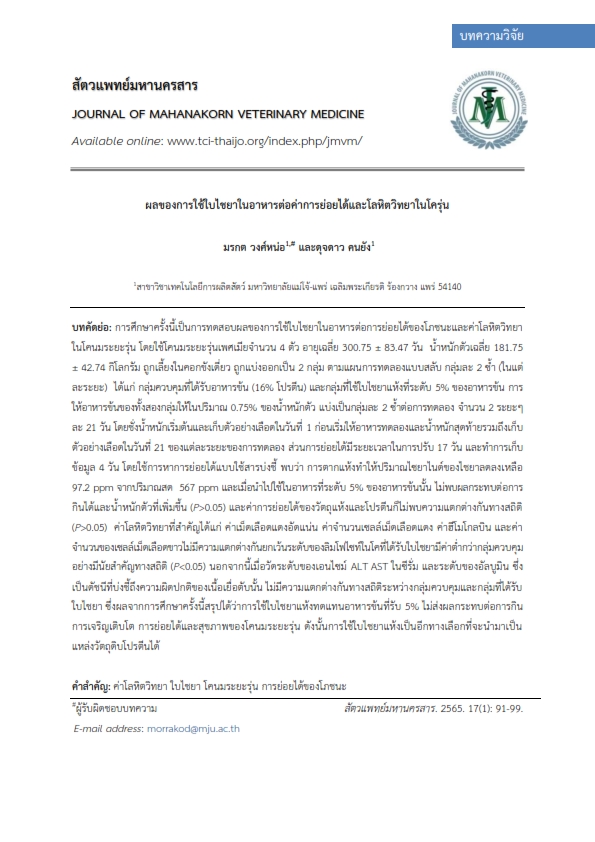Effect of Feeding Chaya (Cnidoscolus chayamansa) Leaf on Nutrient Digestibility and Blood Profiles in Growing Dairy Cattle
Main Article Content
Abstract
The aim of this study was to investigate the effect of feeding dried chaya (Cnidoscolus chayamansa) leaf on nutrient digestibility and blood profiles in growing dairy cattle. Four Holstein-Friesian growing heifers averaging 181.75 ± 42.74 kg of body weight and 300.75 ± 83.47 d of age were randomly assigned to a change over design in two periods with two treatments as follows: control group and replacing concentrate with 5% chaya leaf. The concentrate was given 0.75% of BW with fresh pangola grass as roughage. There were 17 d adaptation in each period, followed by 4 d measurement period for fecal sample collection. Blood collection was collected in each cow: pre and post-trial via jugular venipuncture. The result of this study revealed that cyanide content in dried chaya leaf was 97.2 ppm. Compared to control group, body weight gain, average daily gain, dry matter intake and G : F were not significantly different (P>0.05). There were no significant differences in dry matter and crude protein digestibility between groups. The 5% chaya leaf had no impact on PCV, RBC, hemoglobin, MCV, MCH and MCHC values. While lymphocytes of the cow fed 5% dried chaya leaf was significantly lower (P<0.05) than lymphocytes of the control group. Blood chemistry serum such as total protein, albumin, AST and ALT of 5% chaya leaf were not significantly different from the control group. This study indicates that the replacement of concentrate with 5% dried chaya leaf can be used as a feed ingredient since it has no effect on growth and health in growing dairy cattle.
Article Details

This work is licensed under a Creative Commons Attribution-NonCommercial-NoDerivatives 4.0 International License.
References
Addass, P.A., David, D.L., Edward, A., Zira, K.E. and Midau, A. 2012. Effect of Age, Sex and Management System on Some Haematological Parameters of Intensively and Semi-Intensively Kept Chicken in Mubi, Adamawa State, Nigeria. Iran. J. Appl. Anim. Sci. 2: 277-282.
Association of Official Analytical Chemists. 1984. Official methods of analysis of the Association of Official Analytical Chemists, 14th ed. AOAC, Arlington, VA. 121 p.
Chikezie, U.N., Chijioke, A.N., Adjeroh, L.A., Ogbulie, T.E., Udensi, J.U. and Oyirioha, K.C. 2016. An evaluation of the phytochemical and nutritional compositions of fresh leaves of Cnidoscolus aconitifolius [Miller] IM Johnston. Int. J. Res. Stud. Biosci. 4(6): 21-28.
Chineke, C.A., Ologun, A.G. and Ikeobi, C.O.N. 2006. Haematological Parameters in Rabbit Breeds and Crosses in Humid Tropics. Pak. J. Biol. Sci. 9: 2102–2106.
Cope, R.B. 2021 (cited 10 October 2021). Cyanide Poisoning in Animals. Merck & Co., Inc., Kenilworth, NJ, USA. https://www.msdvetmanual.com/toxicology/cyanide-poisoning/cyanide-poisoning-in-animals.
Donkoh, A., Atuahene, C.C., Poku-Prempeh, B. and Twum, I.G. 1999. The nutritive value of chaya leafmeal (Cnidoscolus aconitifolius (Mill.) Johnston): Studies with broiler chickens. Anim. Feed Sci. Technol. 77: 163–172.
González-Laredo, R., Flores De La Hoya, M.E. and Quintero-Ramos, M.J. 2003. Flavonoid and cyanogenic contents of chaya (spinach tree). Plant. Foods. Hum. Nutr. 58: 1–8.
Kumar, A., Singh, K.K., Das, M.M. and Pathak, S. 2010. Effect of replacement of concentrate mixture with chaya (Cnidoscolus aconitifolius) fodder meal on feed intake and digestibility of nutrients in growing goats. Indian. J. Anim. Sci. 80: 910–912.
Kumar, R. 1992 (cited 10 November 2021). Anti-nutritional factors, the potential risks of toxicity and methods to alleviate them. Legume trees and other fodder trees as protein source for livestock. FAO Animal Production and Health Paper. 102: 145–160. https://www.fao.org/waicent/FAOINFO/Agricult/aga/AGAP/FRG/AHPP102/102-145.pdf.
Kuri-GarcÃa, A., Chávez-ServÃn, J.L. and Guzmán-Maldonado, S.H. 2017. Phenolic profile and antioxidant capacity of Cnidoscolus chayamansa and Cnidoscolus aconitifolius: A review. J. Med. Plants. Res. 11(45): 713–727.
Lawal, T.T., Saba, A.B., Ewuola, E.O. and Iyiola–Tunji, A.O. 2010. Haematological responses of adult male rabbits to prolonged administration of chaya plant (Cnidoscolus acotinifolus) extract. Afri. J. Anim. Biomed. Sci.5 (3): 118–122.
Oni, O.O., Adegbenjo, A.A., Akinade, A. and Popoola, L. 2017. Evaluation of blood parameters of broiler chickens fed diet supplemented with embaceryl and chaya leaf (Cnidoscolus aconitifolius). Bull. Anim. Health Prod. Afr. 65: 103–108.
Pérez-González, M.Z., Siordia-Reyes, A.G., Damián-Nava, P., Hernández-Ortega, S., Macías-Rubalcava, M.L. and Jiménez-Arellanes, M.A. 2018. Hepatoprotective and anti-inflammatory activities of the Cnidoscolus chayamansa (Mc Vaugh) leaf extract in chronic models. Evid. Based Complement. Alternat. Med. 1–12.
Roland, L., Drillich, M. and Iwersen, M. 2014. Hematology as a diagnostic tool in bovine medicine. J. Vet. Diagn. Invest. 26(5): 592–598.
Totakul, P., Matra, M., Sommai, S. and Wanapat, M. 2021a. Cnidoscolus aconitifolius leaf pellet can manipulate rumen fermentation characteristics and nutrient degradability. Anim. Biosci. 34(10):1607–1615.
Totakul, P., Viennasay, B., Sommai, S., Matra, M., Infascelli, F. and Wanapat, M. 2021b. Supplemental effect of Chaya (Cnidoscolus aconitifolius) leaf pellet on rumen fermentation, nutrients digestibility and microbial protein synthesis in growing crossbred bulls. Ital. J. Anim. Sci. 20(1): 279–287.


